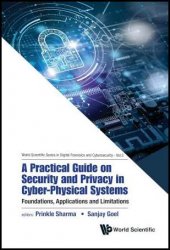 Название: A Practical Guide on Security and Privacy in Cyber-Physical Systems: Foundations, Applications and Limitations
Название: A Practical Guide on Security and Privacy in Cyber-Physical Systems: Foundations, Applications and LimitationsАвтор: Prinkle Sharma, Sanjay Goel
Издательство: World Scientific Publishing
Год: 2024
Страниц: 264
Язык: английский
Формат: pdf (true)
Размер: 16.1 MB
A Practical Guide on Security and Privacy in Cyber-Physical Systems offers an in-depth look at the recent security and privacy challenges of Cyber-Physical Systems (CPS) in multiple application domains. It provides readers with a comprehensive view of system architecture for cybersecurity systems before actual implementation.The book first presents a systematic overview on several CPS applications covering standard architectures before zooming into each of the layers of the architectureal design to describe the underpinning technological, security, and privacy issues currently facing some CPS research groups. The guiding principles that should be followed while planning future innovations for such mission-critical systems are also covered.This book captures the latest advancements from many different fields and is a well-balanced combination of academic contributions and industrial applications in CPS. Written for students and professionals at all levels, this book presents the best practices for individuals who want to advance their research and development in this exciting area.
The Internet has seen transformation several times since its inception — from the introduction of various forms of electronic communication to e-commerce, social media, and cyber-physical systems (CPSs); each has deeply impacted society. The most recent development incorporates CPSs where sensors and actuators enable the Internet to impact the physical world. Three major innovations driving technologies all rest on CPSs: smart power grids, smart wearable/implantable/medical devices, and connected/autonomous vehicles.
While each of these innovators can single-handedly transform society, security and privacy concerns still loom overhead and need to be addressed adequately to ensure the mobility of these systems. Because CPSs have real-world impacts on the physical world through the Internet, hackers can exploit this connection to cause damage to life and property. Just imagine a ransomware attack where the hacker has control of the oxygen supply of a hospital in a way that grants them the ability to kill patients if the ransom demand is not met. Another scenario is where a hacker can gain access to the vehicles in a transportation network and disable the self-driving cars’ collision avoidance systems, resulting in numerous accidents on the highway. Both examples show that the Internet’s impact on society is growing exponentially, as is the potential for damage through attacks.
Chapter 1 covers the basic components and computing concepts required for structuring any cyber-physical system. It identifies the key requirements for developing CPS architecture from initial requirements to certification and deployment. The chapter also explains CPSs’ components, their properties, and the computing constraints of the physical world.
Chapter 2 presents the various wireless MAC protocols and techniques for achieving real-time and reliable communications in CPSs in detail. It also discusses the protocols and requirements needed at the networking layers for these applications. It evaluates the IEEE standard 802.15.4 for configuring and optimizing the design parameters of the MAC protocols.
Chapter 3 discusses the forensic analysis and tools required to investigate incidents when security measures fail to safeguard the CPSs. It covers the technical and legal aspects of digital forensics in CPSs and reviews current challenges that need to be addressed by the developers of CPSs.
Chapter 4 highlights another application domain of CPSs — cloud computing — which is proving to be a strong solution to an organization’s and individual’s ever-increasing storage and processing needs, without the hassle of owning and managing physical hardware.
Chapter 5 provides a detailed review of various vulnerability challenges in smart cities and a foundation for classifying current and future advancements in this field.
Chapter 6 examines the self-healing capability of a smart grid system after a power failure. The work focuses on the potential cyberattacks that could disrupt the functioning of the CPSs.
Chapter 7 analyzes the existing Industrial Control Systems (ICS) security curricular guidance to explore its potential in information technology (IT) and operational technology (OT) within CPSs.
Скачать A Practical Guide on Security and Privacy in Cyber-Physical Systems: Foundations, Applications and Limitations